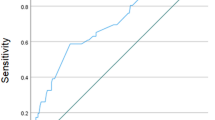Abstract
Purpose
We investigated oncological outcomes in Japanese patients who underwent robot-assisted radical prostatectomy (RARP).
Materials and methods
This study included 389 patients who underwent RARP at a single institution with a follow-up period of at least 1 year. Preoperative findings were compared with biochemical recurrence (BCR). Predictors of BCR-free survival (BCRFS) were evaluated by univariate and multivariate Cox proportional hazard model analyses, and a risk stratification model based on the relative risks of BCR was established.
Results
Fifty incidences of BCR were noted during a median follow-up period of 28.7 months (range, 12.1–80.0 months). The BCRFS rate for the entire cohort at the median follow-up time was 85.9 %; the 1-, 3-, and 5-year estimates were 91.0, 85.1, and 81.1 %, respectively. From univariate analyses, prostate-specific antigen (PSA), PSA density, biopsy Gleason score, and percent positive core were significantly associated with BCR. Multivariate analysis showed that PSA [hazard ratio (HR), 2.75; p = 0.001], percent positive core (HR, 2.22; p = 0.001), and biopsy Gleason score (HR, 2.61; p = 0.007) were independent predictors of BCR.
Conclusion
This study at a single Japanese center demonstrates that RARP provides a satisfactory BCRFS rate. This report provides a framework with which to estimate oncological outcomes in patients who underwent RARP for localized prostate cancer. Our results support the increased use of RARP for the treatment of localized prostate cancer in Japan.


Similar content being viewed by others
References
Liss MA, Lusch A, Morales B et al (2012) Robot-assisted radical prostatectomy: 5-year oncological and biochemical outcomes. J Urol 188:2205–2211
Suardi N, Ficarra V, Willemsen P et al (2012) Long-term biochemical recurrence rates after robot-assisted radical prostatectomy: analysis of a single-center series of patients with a minimum follow-up of 5 years. Urology 79:133–138
Lowrance WT, Elkin EB, Jacks LM et al (2010) Comparative effectiveness of prostate cancer surgical treatments: a population based analysis of postoperative outcomes. J Urol 183:1366–1372
Patel VR, Coelho RF, Rocco B et al (2011) Positive surgical margins after robotic assisted radical prostatectomy: a multi-institutional study. J Urol 186:511–516
Patel VR, Abdul-Muhsin HM, Schatloff O et al (2011) Critical review of ‘pentafecta’ outcomes after robot-assisted laparoscopic prostatectomy in high-volume centres. BJU Int 108:1007–1017
Yoshida T, Nakayama M, Matsuzaki K et al (2011) Validation of the Prostate Cancer Risk Index (PRIX): a simple scoring system to predict risk of biochemical relapse after radical prostatectomy for prostate cancer. Jpn J Clin Oncol 41:1271–1276
Han M, Partin AW, Zahurak M et al (2003) Biochemical (prostate specific antigen) recurrence probability following radical prostatectomy for clinically localized prostate cancer. J Urol 169:517–523
Pound CR, Partin AW, Eisenberger MA et al (1999) Natural history of progression after PSA elevation following radical prostatectomy. JAMA 281:1591–1597
Ishizaki F, Hoque MA, Nishiyama T et al (2011) External validation of the UCSF-CAPRA (University of California, San Francisco, Cancer of the Prostate Risk Assessment) in Japanese patients receiving radical prostatectomy. Jpn J Clin Oncol 41:1259–1264
Cooperberg MR, Broering JM, Kantoff PW et al (2007) Contemporary trends in low risk prostate cancer: risk assessment and treatment. J Urol 178:S14–S19
Hernandez DJ, Nielsen ME, Han M et al (2007) Contemporary evaluation of the D’Amico risk classification of prostate cancer. Urology 70:931–935
Novara G, Ficarra V, Mocellin S et al (2012) Systematic review and meta-analysis of studies reporting oncologic outcome after robot-assisted radical prostatectomy. Eur Urol 62:382–404
Coughin G, Dangle PP, Palmer KJ et al (2009) A thermal early retrograde release of the neurovascular bundle during nerve-spearing robotic-assisted laparoscopic radical prostatectomy. J Robot Surg 1:13–17
Atzpodien J, Royston P, Wandert T et al (2003) Metastatic renal cell carcinoma comprehensive prognostic system. Br J Cancer 88:348–353
Hashimoto T, Ohno Y, Nakashima J et al (2013) Clinical significance of preoperative peripheral blood neutrophil count in patients with non-metastatic upper urinary tract carcinoma. World J Urol 31:953–958
Harrell FE, Lee KL, Mark DB (1996) Multivariable prognostic models: issues in developing models, evaluating assumptions and adequacy, and measuring and reducing errors. Stat Med 15:361–387
Menon M, Bhandari M, Gupta N et al (2010) Biochemical recurrence following robot-assisted radical prostatectomy: analysis of 1384 patients with a median 5-year follow-up. Eur Urol 58:838–846
Sooriakumaran P, Haendler L, Nyberg T et al (2012) Biochemical recurrence after robot-assisted radical prostatectomy in a European single-centre cohort with a minimum follow-up time of 5 years. Eur Urol 62:768–774
Murphy DG, Kerger M, Crowe H et al (2009) Operative details and oncological and functional outcome of robotic-assisted laparoscopic radical prostatectomy: 400 cases with a minimum of 12 months follow-up. Eur Urol 55:1358–1366
Ritch CR, Morrison BF, Hruby G et al (2013) Pathological outcome and biochemical recurrence-free survival after radical prostatectomy in African-American, Afro-Caribbean (Jamaican) and Caucasian-American men: an international comparison. BJU Int 111:E186–E190
Radwan MH, Yan Y, Luly JR et al (2007) Prostate-specific antigen density predicts adverse pathology and increased risk of biochemical failure. Urology 69:1121–1127
Fu Q, Moul JW, Bañez LL et al (2010) Total PSA, PSA density and biopsy Gleason score in predicting the pathologic stage of prostate cancer. Zhonghua Nan Ke Xue 16:415–419 (in Chinese)
Reese AC, Cooperberg MR, Carroll PR (2010) Minimal impact of clinical stage on prostate cancer prognosis among contemporary patients with clinically localized disease. J Urol 184:114–119
Conflict of interest
The authors declare that they have no conflict of interest.
Author information
Authors and Affiliations
Corresponding author
About this article
Cite this article
Hashimoto, T., Yoshioka, K., Gondo, T. et al. Preoperative prognostic factors for biochemical recurrence after robot-assisted radical prostatectomy in Japan . Int J Clin Oncol 19, 702–707 (2014). https://doi.org/10.1007/s10147-013-0611-0
Received:
Accepted:
Published:
Issue Date:
DOI: https://doi.org/10.1007/s10147-013-0611-0




